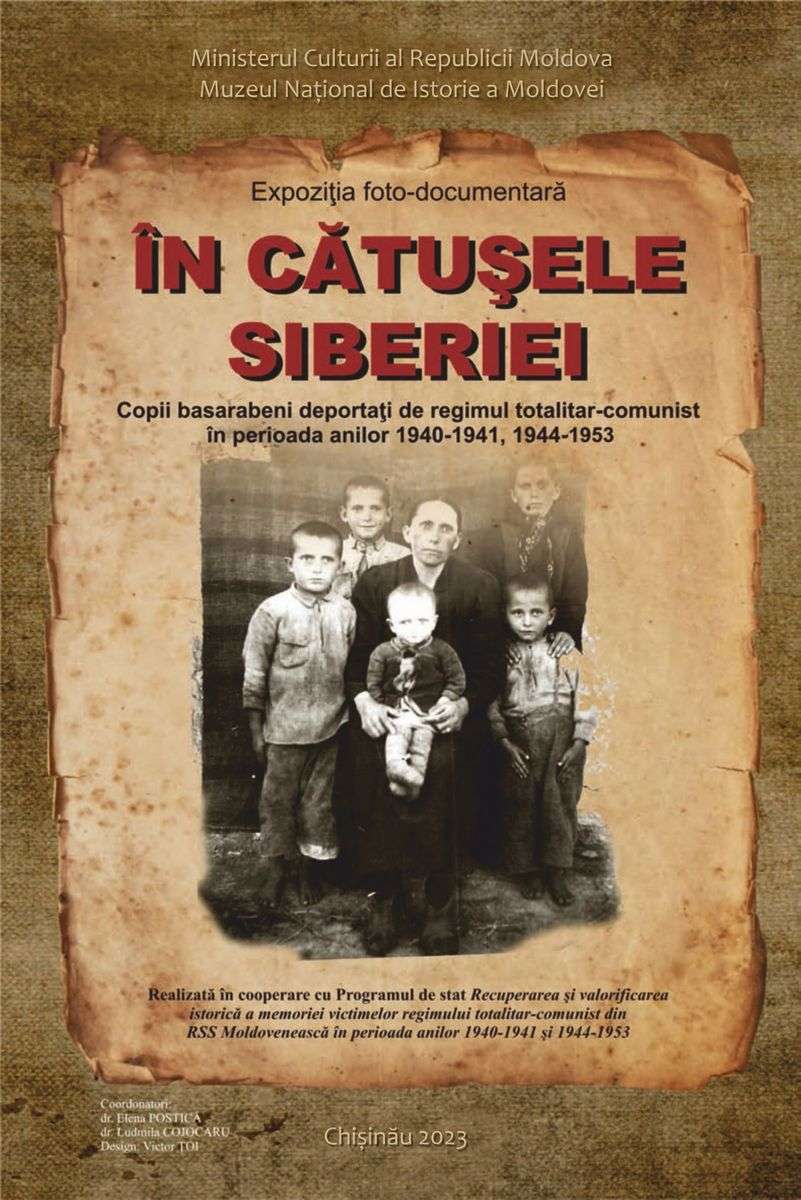 The exhibition "In Siberian Shackles. Bessarabian children deported by the totalitarian-communist regime during the years 1940-1941 and 1944-1953" presents the life of children exiled in the Soviet Gulag. The photo-documentary testimonies and documents brought to the attention of the visitors reproduce the emotional sensitivity, experiences and traumatic memories of a generation in relation to its own past.
The exhibition "In Siberian Shackles. Bessarabian children deported by the totalitarian-communist regime during the years 1940-1941 and 1944-1953" presents the life of children exiled in the Soviet Gulag. The photo-documentary testimonies and documents brought to the attention of the visitors reproduce the emotional sensitivity, experiences and traumatic memories of a generation in relation to its own past.
Despite Stalin's 1935 assertion that "the son is not responsible for the deeds of the father", the Soviet authorities resorted to convicting all family members and inoculating collective guilt. Soon, the expression "child of the kulak" came to produce shivers of horror among Bessarabian children, considered "agents of socialist transformations".
In June 1941, 3.470 families of "anti-Soviet elements" (22.648 people), including children of these families, were deported from the Moldavian SSR. In July 1949, as part of the "South" Operation, 11.293 families (35.796 people) were deported, including 11.899 children. In 1951, for religious reasons, 723 families (2.724 people), including 799 children, were forced to leave the Moldavian SSR. The families of the deportees were transported in cattle wagons and placed in localities with a forced residence regime, under the supervision of the commandant. The feeding of all people in the first years of deportation was exclusively within the limits of the bread ration, the children of "enemies of the people" being often omitted from the supply lists in which only persons trained in the field of labor were enrolled. Along with the deported parents, the children were forced to adapt to the extreme conditions, by developing new roles and social networks: by interacting with local people and local authorities; by integrating, as much as possible, into the foreign cultural environment; by learning the Russian language, declared the official language of communication in the USSR space; by performing political loyalty and practicing self-censorship, which facilitated reintegration into society.
The narratives of children educated during the years of Soviet power in the Moldavian SSR contain experiences, attitudes, events, which reveal their individual vision of the past, their personal experience of confronting the system. Silence and self-censorship were among the strategies imposed, and the attitude of the repressive system towards children deported through the application of denationalization policies reflects the essence of Soviet society in general. However, as shown by the images and documents presented in the exhibition, the party-state's project regarding the construction of the "happy childhood in the USSR" suffered serious derailments and random adjustments, becoming an ideological template intended to cover up the horrors of the totalitarian-communist regime.
The exhibition brings together about 100 photographic images, accompanied by memories and archival documents that reflect the GULAG period of children deported from the Moldavian SSR, during the three waves of mass deportations carried out by the Soviet authorities in 1941, 1949 and 1951. The photo-documentary images were selected from the NMHM patrimony and from the collections recently recovered in different localities of the Republic of Moldova, accompanied by maps of the Soviet GULAG, decisions and documents of the repression bodies that reveal the way the deportation operations were carried out, the conditions of living, schooling and working in Siberia and Kazakhstan.
The exhibition "In Siberian Shackles. Bessarabian children deported by the totalitarian-communist regime during the years 1940-1941 and 1944-1953" is a memory tribute to the children who went through the atrocities of the totalitarian-communist regime in the USSR, as well as a pubic action condemning the war launched by the Russian Federation against Ukraine.
The exhibition will be open to the public in the upper hall of the Museum until July 31, 2023.





 The side panels are elegantly decorated with refined cast-iron elements in the Art Nouveau style, displaying the brand name - "Ideal." The Polyglott model, featuring a bilingual keyboard patented in the United Kingdom by Max Klaczko from Riga, Latvia, was produced between 1902 and 1913, marking the first typewriter capable of writing in two languages. The "Ideal Polyglott" typewriter was actively sold in the Russian Empire and gained significant popularity in Poland, Bulgaria, and Serbia.
The side panels are elegantly decorated with refined cast-iron elements in the Art Nouveau style, displaying the brand name - "Ideal." The Polyglott model, featuring a bilingual keyboard patented in the United Kingdom by Max Klaczko from Riga, Latvia, was produced between 1902 and 1913, marking the first typewriter capable of writing in two languages. The "Ideal Polyglott" typewriter was actively sold in the Russian Empire and gained significant popularity in Poland, Bulgaria, and Serbia.













































